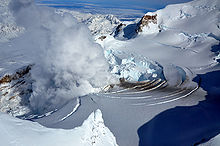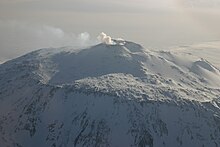
Back بركان تحت جليدي Arabic Subglazialer Vulkan German Volcán subglaciar Spanish آتشفشان زیریخچالی Persian Volcan sous-glaciaire French Vulcano subglaciale Italian Subglaciale vulkaan Dutch Vulcão subglacial Portuguese Подлёдный вулкан Russian Підлідний вулкан Ukrainian








A subglacial volcano, also known as a glaciovolcano, is a volcanic form produced by subglacial eruptions or eruptions beneath the surface of a glacier or ice sheet which is then melted into a lake by the rising lava. Today they are most common in Iceland and Antarctica; older formations of this type are found also in British Columbia and Yukon Territory, Canada.
During the eruption, the heat of the lava from the subglacial volcano melts the overlying ice. The water quickly cools the lava, resulting in pillow lava shapes similar to those of underwater volcanoes. When the pillow lavas break off and roll down the volcano slopes, pillow breccia, tuff breccia, and hyaloclastite form. The meltwater may be released from below the ice as happened in Iceland in 1996 when the Grímsvötn caldera erupted, melting 3 km3 of ice and giving rise to a large glacial lake outburst flood.
The shape of subglacial volcanoes tends to be quite characteristic and unusual, with a flattened top and steep sides supported against collapse by the pressure of the surrounding ice and meltwater. If the volcano eventually melts completely through the ice layer, then horizontal lava flows are deposited, and the top of the volcano assumes a nearly level form. However, if significant amounts of lava are later erupted subaerially, then the volcano may assume a more conventional shape. In Canada the volcanos have been known to form both conical and nearly level shapes.[1] The more distinctly flat-topped, steep-sided subglacial volcanoes are called tuyas, named after Tuya Butte in northern British Columbia by Canadian geologist Bill Mathews in 1947. In Iceland, such volcanoes are also known as table mountains.
- ^ "Volcanoes of Canada". Geological Survey of Canada. Archived from the original on February 2, 2009. Retrieved January 19, 2009.